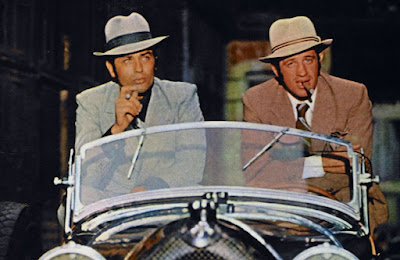 |
| Images courtesy of Paramount Pictures |
Jean-Paul Belmondo and Alain Delon were arguably two of France’s
greatest and most charismatic screen actors having appeared in numerous Jean-Luc
Godard and Jean-Pierre Melville pictures.
French cinema heartthrobs of the highest order, it was only a matter of
time before these screen giants would be paired together in what became French
crime film director Jacques Deray’s most famous international success in the 1970
period crime dramedy Borsalino released through Paramount Pictures and
now in a 4K restored limited edition set from Arrow Films.
A film that played up their screen charms while offering up
a snapshot of a particular era of French gangsters in the early 1930s. Loosely based on gangsters Paul Carbone and François
Spirito before the names and events were loosely changed to avoid details of
the duo’s later collaboration with the Nazis, Borsalino lifts its title
from the fedora-style hat company whose golden age thrived in the era being depicted
and as a result there was brief renewed interest in Borsalino hat sales. Perhaps one of the most entertaining period
gangster epics predating The Godfather and The Sting while also
gradually peppering in further elements of a genre thriller.
Beginning simply enough, in 1930 Marseille small time crook
Roch Siffredi (Alain Delon) finishes his prison time and tracks down his
girlfriend Lola (Catherine Rouvel) now residing with equally petty criminal François
Capella (Jean-Paul Belmondo). After an
extended fistfight leaving the two bloodied and bruised, the twosome buddies up
with Lola and form a business partnership that skyrockets them to the top of
the ranks of the French criminal empire in Marseille. Soon as they reach the peak, however, the
film’s whimsical carefree and even comedic attitude starts to shift as more
assassination attempts and double crossings come their way trying to dethrone
them from power.
Initially a charming period mob movie playing on the screen
charisma of the two leads who reportedly had a falling out after the film was
finished, the picture co-produced by Alain Delon gradually takes on the form of
a genre thriller as numerous attempts are made on the partners’ lives and they
are forced to go into hiding amid Tommygun shootouts and stabbings. Aided by a delightfully appropriate piano period
soundtrack by Claude Bolling which sounds frankly like big band music of the
1930s played in speakeasies, arrestingly ornate cinematography by Jean-Jacques
Tarbès and acute attention to period detail by the costume designer Jacques
Fonteray (Barbarella), production design and set decorators, Borsalino
quite literally transports you back into a bygone era.
Of course the film wouldn’t be half as magnetic without the
larger-than-life screen presence of not one but two of France’s finest and most
alive actors in the business who play off of each other brilliantly. Whether they got along offscreen or not is
anyone’s guess but onscreen they make quite a tag-team. Even as we wade deeper into crime with two
mercenary characters who can and will kill to maintain their positions of
power, we can’t help but want to root for these bad boys and see them “succeed”.
While considered at the time to be one of the most expensive
French films ever made with much of the money funneled in by Paramount Pictures
and despite the falling out of its two leads which eventually led to legal
action by Belmondo against his costar Delon, Borsalino nevertheless went
on to enjoy commercial success in its country of origin. Despite an ongoing scandal known as the Markovic
affair still plaguing Alain Delon’s public image and weaker US box office
returns, Borsalino took its spot immediately in the pantheon of
underrated and overlooked gangster epics.
For its massive French success and the pedigree of the two
leads, it is a shame it remains still mostly unknown outside of France. Hopefully with Arrow Video’s new deluxe
limited edition set jam packed with extras, that will change. While not necessarily a masterpiece of crime
cinema with the real details of the characters inspiring the film more or less censored
from discussion, the screen presence broadcast by the two leads is undeniable
and even if they didn’t get along it is still exhilarating to see them onscreen
together in a most delightfully entertaining historical period crime saga.
--Andrew Kotwicki




